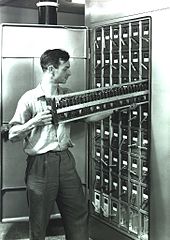EDSAC 2 was an early vacuum tube computer (operational in 1958), the successor to the Electronic Delay Storage Automatic Calculator (EDSAC). It was the first computer to have a microprogrammed control unit and a bit-slice hardware architecture.[1]

First calculations were performed on the incomplete machine in 1957.[2] Calculations about elliptic curves performed on EDSAC-2 in the early 1960s led to the Birch and Swinnerton-Dyer conjecture, a Millennium Prize Problem, unsolved as of 2024. And in 1963, Frederick Vine and Drummond Matthews used EDSAC 2 to generate a magnetic anomaly map of the seafloor from data collected in the Indian Ocean by H.M.S. Owen, key evidence that helped support the theory of plate tectonics.[3]
References
- ^ a b c d e Wilkes, M.V. (1992). "EDSAC 2". IEEE Annals of the History of Computing. 14 (4). PDF available by "View PDF" (expand "View on IEEE"): 49–56. doi:10.1109/85.194055. S2CID 11377060.
- ^ "New computer in Cambridge". New Scientist. Reed Business Information. 8 August 1957. p. 31.
- ^ Vine, Fred J.; Matthews, Drummond H. (1963). "Magnetic anomalies over oceanic ridges". Nature. 199 (4897): 947–949. Bibcode:1963Natur.199..947V. doi:10.1038/199947a0. S2CID 4296143.
External links
 Media related to EDSAC 2 at Wikimedia Commons
Media related to EDSAC 2 at Wikimedia Commons


Recent Comments